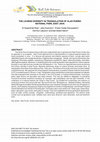Papers by Iin Supartinah Noer

AbstractTaxonomic study of beard moss (Usnea spp) at Priangan, was carried out by using morpholog... more AbstractTaxonomic study of beard moss (Usnea spp) at Priangan, was carried out by using morphological, anatomical and chemical's characters. Sample have taken from five area, they are Jayagiri conifer forest (Bandung), Rancakalong conifer forest (Sumedang), Kamojang conifer forest ( Garut), Munjul conifer forest (Ciamis) and Cigorowong conifer forest ( Tasikmalaya). Morphological observation was done on thallus and anatomical observation in medulla, axis and ratio of cortex : medulla : axis. While chemical analysis was conducting by colour test and crystal test. The identification result founded the eleven species, i.e. Usnea baileyi, U.ceratina, U.cornuta, U.filipendula, U. flexilis, U. flexuosa, U.florida, U.glabrata, U.hirta, U. longissima and U. trichodea. Morphological characters that can be used for distinguished of eleven species of Usnea are medulla shape, axisshape, radius of cortex, radius of medulla and diameter of axis. Chemical characters distinguished are reagent K,C, KC and IKI. Based on that characters the key identification have made for Usnea species founded at Priangan and de3scription were arranged for genus and species level. Phenetic analysis done by using NTSY Spc versi 2.0, resulted a Dendrogram which the eleven species of Beard moss can be divided into three branches. The first branch consist of U.baileyi and U.ceratina, the second are U.cornuta, U.flexilis, U.florida, U. flexuosa and U.glabrata and the third branch branch consist of U.filipendula, U.hirta, U.trichodea and U.longissima. Key word : Characterization, relationship, Beard moss, Usnea , Prianga
Bulletin of Health Research, 1991
Mosquito population and some of the ecological aspects of the environment were studied in an obse... more Mosquito population and some of the ecological aspects of the environment were studied in an observation conducted in seven villages around the Grata dam project area from April 1956 through March 1987. One of the aims of this study was to evaluate the impact of the dam project toward the mosquito population, as a part of environmental impact analysis, and also to observe development of other impacts that could be anticipated from the dam construction. Both human bait and light trap methods were used for mosquito collections. Statistical method of Index of Diversity of Shanon - Wiener, Summed Dominance Ratio, and chi-square test were utilized for data analysis. Eighteen mosquito species were found and twelve of them are known as vectors for some viral diseases: Culex vishnui, Cx. tritaeniorhynchus, and Cx. quinquefasciatus.

De p a rt m e nt o f Int e rna l M e d ic ine , Ho ly Fa m ily Ho s p it a l, T h e Cat ho lic U ... more De p a rt m e nt o f Int e rna l M e d ic ine , Ho ly Fa m ily Ho s p it a l, T h e Cat ho lic U n iv e rs ity o f Ko re a Co lle g e o f M e d ic ine , Puc he o n , Ko re a B a c kg ro u n d : O n e o f t h e m aj o r m o rp h o lo g ic c h a ra ct e ris t ic s o f h e p at it is B is a h e p a t o c e llu la r re g e n e rat io n w h ic h is in d u c e d by m a s s iv e h e p at o cy t e n e c ro s is a n d a s s o c ia t e d w it h p ro lif e ra t iv e a c t iv ity o f h e p a t o cy t e s. T h e p u rp o s e o f t h is s t u d y is t o d o c u m e nt t h e p ro lif e ra t iv e a c t iv ity o f h e p a t o cy t e s in v a rio u s ty p e s o f h e p at it is B by im m u n o h is t o c h e m ic a l s t a in ing f o r p ro lif e ra t iv e c e ll n u c le a r a n t ig e n-la b e llin g in d e x (PC N A-L I) a n d e le ct ro n m ic ro s c o p y. M e t h o d s : W e s t u d ie d 8 3 p at ie nt s w it h h e p a t it is B ; 1 1 c a s e s o f a c ut e v ira l h e p at it is , 24 c as e s o f m ild c h ro n ic h e p at it is , 34 ca s e s o f s e v e re c h ro n ic h e p at it is w it h e a rly c irrh o s is a nd 14 c as e s o f s e v e re c h ro n ic he p at it is. T h e PCN A w a s t e s t e d by im m u n o h is t o c h e m ica l s t a in ing u s ing a nt i-PC N A a nt ib o dy. Fu rt h e rm o re w e e v a luat e d t h e u lt ra s t ru ct u re o f a c in u s-f o rm ing h e p at o cy t e s (A FH) by e le ct ro n m ic ro s c o py. R e s u lt s : T h e e x p re s s io n ra t e a n d la b e llin g in d e x o f P C N A w e re 2 7. 3 % a n d 5 .3 0. 9 % in a c ut e v ira l h e p at it is , 6 2. 5 % a nd 2 2 .9 3 1. 7 % in m ild c h ro n ic h e p a t it s , a n d t h e n 4 7. 1 % a n d 14. 1 2 4. 2 % in s e v e re c h ro n ic h e p at it is w it h e a rly c irrh o s is , re s p e c t iv e ly (F ig u re 1). By c o nt ra s t , n o d e t e ct a b le PC N A e x p re s s io n w a s n o t e d in A F H. E le ct ro n m ic ro s c o p ic f in d ing s s h o w e d t h at h e p at o cy t e s f o rm in g a ro s e t t e u n d e rw e nt m a rk e d d e g e n e ra t iv e c h a n g e s w it h s in u s o id a l c a p illa riz at io n a n d in c re a s e d f in e s t ra n d s o f c o llag e n f ib e r in p o rt a l a re a. Co n c lu s io n : T h e p ro lif e rat iv e a c it iv ity o f he p at it is B w a s s ig n if ic a nt ly d e c re a s e d in s e v e re c h ro n ic h e p at it is c o nt a in ing A FH. T h is re s u lt s ug g e s t e d t hat d if f e re n ce s in p ro lif e rat iv e a ct iv ity w as a s s o c iat e d w it h he p at ic c e ll ne c ro s is a nd A FH.

The Lichenologist, 2019
The genus Graphis sensu Staiger was recently divided into two genera, Graphis s. str. and Allogra... more The genus Graphis sensu Staiger was recently divided into two genera, Graphis s. str. and Allographa. The latter contains mostly species with robust lirellae with a well-developed, often massively carbonized excipulum. With one exception, it also contains all species with a pigmented, yellow to orange pruina on the lirellae. Until now, seven species of Allographa were known with this character, all present in the Neotropics and one also in Africa. Here we describe two further species, both from tropical Asia, thus extending the known distribution of Allographa species with pigmented lirellae to the entire tropics. Allographa kamojangensis Jatnika, Noer & Lücking sp. nov. from Indonesia (Java) was recognized as a new taxon on the social media Facebook site Lichens Connecting People. Detailed studies showed that it deviates from the neotropical A. firferi in the much larger ascospores and the orange, K+ immediately purple-violet pigment, and from A. lutea in the completely carbonized ...

Biodiversitas Journal of Biological Diversity, 2018
Kusmoro J, Noer IS, Jatnika MF, Permatasari RE, Partasasmita R. 2018. Lichen diversity in geother... more Kusmoro J, Noer IS, Jatnika MF, Permatasari RE, Partasasmita R. 2018. Lichen diversity in geothermal area of Kamojang, Bandung, West Java, Indonesia and its potential for medicines and dyes. Biodiversitas 19: 2335-2343. The study of lichens diversity in Kamojang, West Java was conducted by survey in geothermal field area following the line transect 6 km along to the East, North West and south from the Power House of Geothermal Power Plant. The lichen samples were taken from bark, soil, and stone. Lichen identification was done by morphological, anatomy and chemical analysis. Dyes potency of Parmotrema and Usnea test using ammoniac fermentation was done in Plant Taxonomy Laboratory of Department Biology, Faculty of Mathematics and Natural Sciences, University of Padjadjaran. The survey has successfully collected 133 species of lichens, belong to 62 genera and 17 families. Parmeliaceae was found as dominant groups, consisting of 33 species and other co-dominant groups are Graphidaceae...

Pests, diseases and weeds are considered as organisms that limiting the agricultural productivity... more Pests, diseases and weeds are considered as organisms that limiting the agricultural productivity. Losses of agricultural productivity originated from the attack of these organisms may be up to 40% to 60%; sometimes in several cases failure of harvests occurred. So far, chemical (synthetic) pesticides are used to control the attack of these organisms. Meanwhile, the use of synthetic pesticides in fact, creates many negative effects on both biotic and abiotic environments, such as pollution against terrestrial and aquatic environments, even killing the vertebrates and husbandry animals, predatory insects, and some economic insects (insect species that benefit to the life of man). Due to the losses created by utilization of synthetic pesticides, therefore a number of scientists and farmers initiated to turn their attention to use the natural pesticides (directly originated from plants) under the light of back to nature principle, although this step is seems to be less effective.Some n...
Biodiversitas Journal of Biological Diversity
The lichen flora of tropical areas is still much under explored, Java in general and the Arboretu... more The lichen flora of tropical areas is still much under explored, Java in general and the Arboretum in West Java in particular, are no exceptions. The Arboretum of the main campus of
Buletin Penelitian Kesehatan, 1991

KnE Life Sciences, 2015
The lichen flora of tropical areas is still much underworked Java in general and Alas Purwo in Ea... more The lichen flora of tropical areas is still much underworked Java in general and Alas Purwo in East Java for specially is no exception. Alas Purwo National Park is representative of a typical lowland tropical rain forest ecosystem in Java.. It is famous with peculiar and endemic species of plant include sawo kecik (Manilkara kauki) and manggong bamboo (Gigantochloa manggong). , beside among the other plants also ketapang (Terminalia cattapa), nyamplung (Calophyllum inophyllum), kepuh (Sterculia foetida), and keben (Barringtonia asiatica). Moreover, in lowland tropical rain forest ecosystem have reported the lichens species diversity is very high and may include over 200 species in 1 ha. There is no reported have found concerning the lichens richness in Alas Purwo. Recently preliminary study of Lichens diversity have been done at triangulation Zone Alas Purwo National Park , East Java. The lichens of the study area have not been treated comprehensively. We explored the lichenological characteristics of putative"tropical lowland cloud forest" (LCF) in a lowland area (0-20ma.s.l.) near Triangulation using macrolichens (cortocoulous species) as indicator taxa We analyzed lichen diversity on 20 trees in two 0,25 ha plots. In tropical lowland forests, corticolous green algal lichens are abundant and highly diverse. This may be related to adaptation to prevailing microenvironmental conditions including, for example, high precipitation and low light intensities. In the understory of a tropical lowland rain forest in Alas Purwo , we studied the morphology and anatomy of corticolous lichens and microcristal test. We found that from Tetrasigma sp , Serbella otodans, Hemandia feltata Baringtonia aciatika Pandanaceae Manilcara cauci Swetinia mahagoni trees there are 30 species of lichens, dominated by Dyorigma sp Graphis and Glyphis from familia of Graphidaceae and Dirinaria Physcia Pyxine Ramalina from familia of Parmeliaceae. The thallus calour was variety from Green-grey, Green-bllue, green, light green, grey, brown, dark green to orange. They have vegetative as wel as generative reproduction such as isidia, soralia, soredia, chypellae, histerothecia, perithecia,and apothecia. The lichenic acids contain such as gyrophoric acid, barbatic acid, usnic acid, atranorin, acid, divaricatic acid and lecanoric acid,

KnE Life Sciences, 2015
Usnea has been used for a long time in Indonesia for traditional medicine and crude material for ... more Usnea has been used for a long time in Indonesia for traditional medicine and crude material for jamu. The study of taxonomy and local knowledge at Priangan are less information. The research was conducted between March 2011-April 2012. The aim of this research was to explore the local knowledge of species Usnea conducted by emic and ethic approaches. The specimens collection was done by survey along the pine forest at Bandung, Sumedang, Garut, Ciamis and Tasikmalaya in Priangan areas. The specimens were analysis morphological, anatomy and chemical. The etnolichenology study was done by descriptive qualitative, survey and interview also observation participative at Gunung Gelap Village and Kamojang area of Garut Regency and Cibunar village,Sumedang Regency in West Java. The interview was done with key informants. The taxonomical study found the 11 species of Beard lichens found in pine forest at Priangan, belong to 3 subgenus. They are subgenus Dilichousnea, consist of Usnea filipendula, U. hirta,U. longisima and U. trichodea. Subgenus Eumitra consist of U.baileyi and U. ceratina. Subgenus Usnea consist of U. cornuta, U. flexilis, Usnea. flexuosa, U. florida and U.glabra. The dominant species growing on pine in different location are U. baileyi and U. flexilis. They have thalli colour dark green, yellow-green, pale green and reddish brown. Thallus branching is dichotomous in all species with difference in the thickness form the isotomic or anisotomic dichotomous types. Species Usnea is fructicose with habits erect type or subpendent type or pendent type.The lichenic acid contain in Usnea species are different and dominant by usnic acid and protocetoric acid. The stictic acid only found in U.flexuosa. The result of interview known that Usnea was called janggot kai by the Sundanese. People grouping the Usnea based on colour, growth pattern and surface of thallus, so known "Janggot kai hejo, janggot kai koneng, janggot kai rubak, janggot kai ngaruntuy, janggot kai kesrak and janggot kai lemes". Mostly the people used Usnea as raru for preservative nira, medicine and spices. The Sudanese used Usnea in formula oj jamu or ubar kampong to treat mouth ulcer, dysentery, catch a cold, skin eruption, stiff, menstruation painful, hemorrhoids,child birth ease and in making mahinum (jamu for mother after utter) and used as face powder of noble woman.










Uploads
Papers by Iin Supartinah Noer